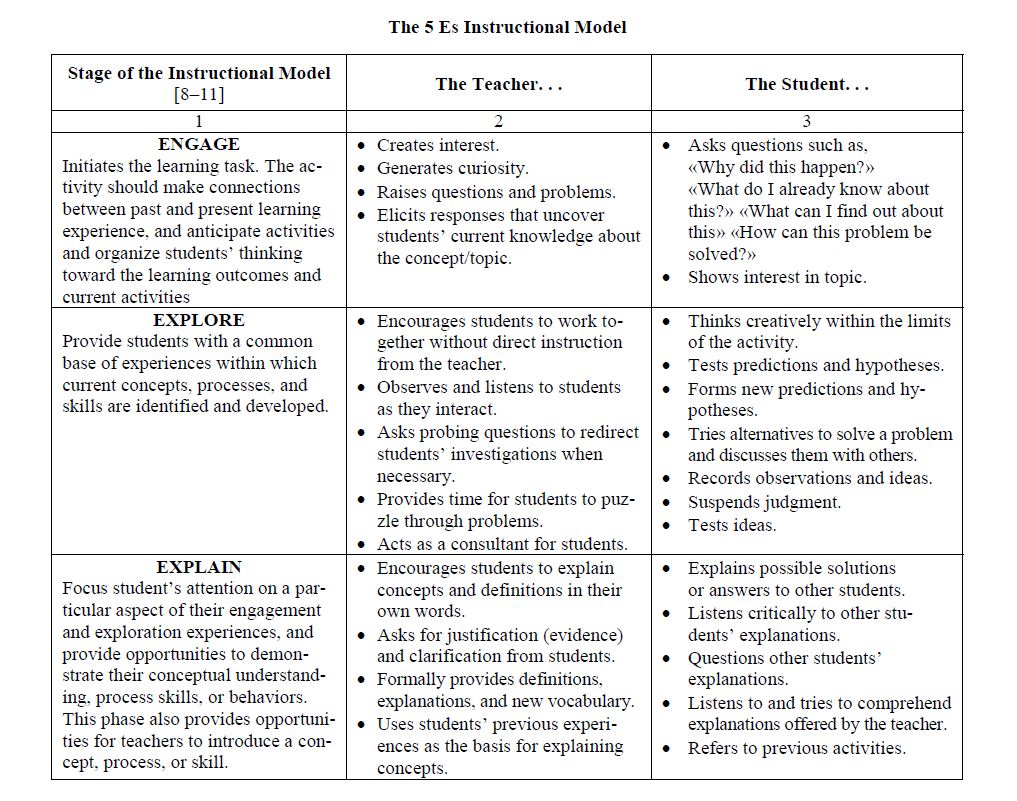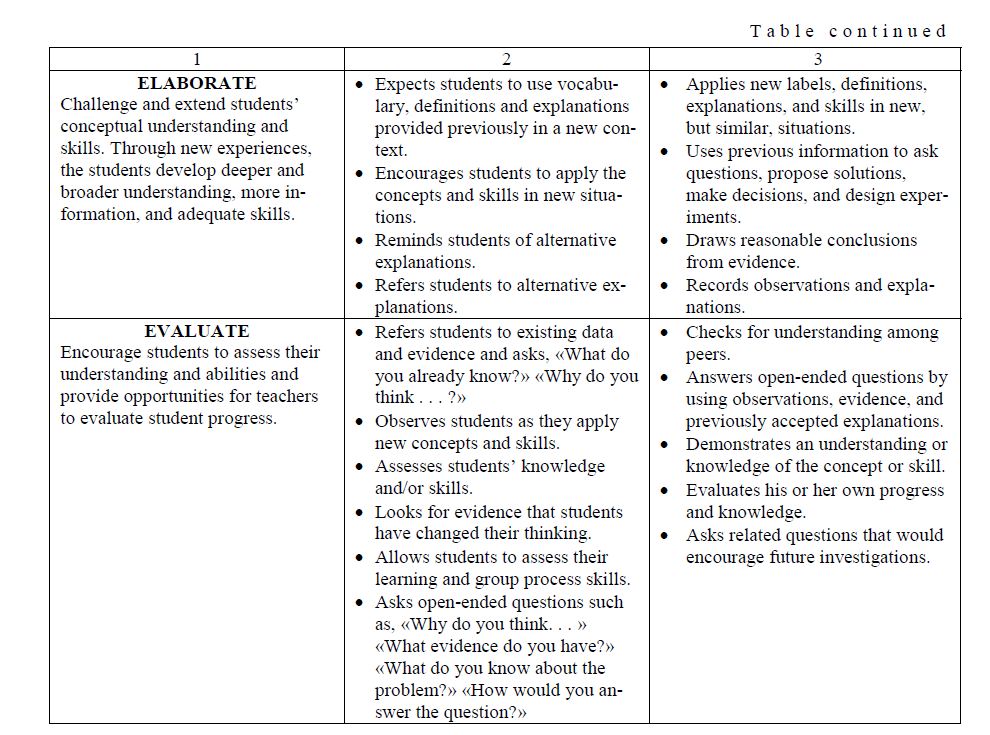There are many theories in the educational process suggesting various methods of teaching sciences in English. This article reveals 5E Instructional Model is unique because it focuses on developing the learners’ knowledge by subsequent teaching and consolidation of knowledge. The model consists of five stages (engagement, exploration, explanation, elaboration, and evaluation). The article contains the table, reviewing recommendations and examples of each stage of this model, that encourage thinking, understanding, exploration, problem solving, collaboration, analysis, observation and prediction.
According to the BSCS 5E Instructional Model, the key strategies to think about when planning a scientific lesson are: engagement, exploration, explanation, elaboration, and evaluation [1]. These 5 items, known as the «5 E's» are essential to engage children in scientific discourse. As we experienced in class, during the lesson revealing the theme «Magnetism», the 5 E's help students to first become excited about the lesson, then engage themselves in hands-on activities, create wonderings, test the wonderings further, and discuss the lesson at the end, allowing for sharing and assessment. The students will gain a lot of information and conclusions during the lesson as well as new wonderings, and this allows for the students to engage in scientific discourse from the intrinsic motivation the lesson gives [2].
Engagement
The first of the 5 E's, engagement, is the first step to introducing the lesson. Engagement involves activating students' prior knowledge about the subject of study. In order to activate prior knowledge, the teacher must hook the students in and make them become interested in the lesson. There are many ways to hook the students, but one great way is through a sort. This allows for a hands-on activity while helping the students to start thinking about what they already know with the items they are sorting. In class, the students were given a bag full of items and instructed to sort the items by whether it is magnetic or not. This allowed for each of them to use their prior knowledge and experiences with magnet in order to help sorting. Another great way to get the students interested in the lesson is by setting up an interesting situation in the classroom and allowing the students to observe and discuss the situation [3]. An example of this was shown in class when the teacher set of the magnet experiment and made the paper clip appear to float. All of students discussed what they thought might happen if an item passed through the magnetic field, and these predictions were based solely on prior knowledge.
Exploration
The next of the 5 E's, exploration, involves performing an experiment to help answer questions and provide further wonderings. While performing the experiment, the student scientists must collect evidence in order to back up any claims made about the experiment. Exploration allows the students to create and test their own experiments with given materials. This process allows for better understanding of the initial concept, and in turn, will help to improve the students' understanding for making claims. We experience exploration in class when each group was given a magnet in order to test the piles created from the previous sort.
Explanation
Explanation is one of the most critical components of the 5 E's model. This part of the lesson facilitates students' discourse and helps the students' focus on the goal of the lesson. From the exploration portion, students will have a few central claims about the topic, and explanation is the opportunity for the students to make these claims public. Once the claims are made public, other classmates can either prove or disprove claims through their own evidence collection. The students’ transition from small group to whole group instruction, bringing materials and questions they have with them to the discussion. Explanation gives the teacher an opportunity to listen to the students' findings and guide the students towards the lesson's goal.
Elaboration
The fourth of the 5 E's is elaboration. Elaboration occurs when the teacher implements strategies to challenge the student's teaching. These strategies often include providing new experiences for the learners. These experiences should stem from the learner's wonderings and should supplement the instruction of the big idea. Elaboration builds on the knowledge and the discourse gained and gives the learner the opportunity to apply understanding to a new experience. Through the new experience a review of old concepts leads the learner to a discover of new knowledge. Our science class observed elaboration when students used their basic knowledge of magnets (from prior knowledge and from the sorting activity) to make a prediction about what objects will affect the magnetic field in the paper clip and magnet experiment [4–6].
Evaluation
Evaluation is the last of the 5 E's. The teacher must create a quality assessment to gauge the learner's understanding of the topic. The students must also be able to reflect on their own understanding and progress. Evaluations should be made before activities to assess prior knowledge, after activities to assess progress, and after the completion of units to assess comprehension [7]. We discussed some ways a teacher could evaluate the learner's during the magnet lesson. This included the teacher or peers review the records in the science notebooks. Also, what students know, what they learned, and what was our evidence components of the chart would give us a general assessment of the learner's as a group.
The 5 Es Instructional Model


Thus, in the classrooms of today, learners neither are no longer passive recipients nor are the teachers the all knowing 'givers of information, knowledge and wisdom' [12]. According to 5E’s perspective, the teaching or rather more precisely learning of sciences is not the search for the ultimate truth. It is the process which is of utmost importance in science than the content. So when the learning of biology involves active construction of knowledge by students, then the classroom environment must call for more synergies rather than mere individual participation. The teachers need to develop the ability to work with students creatively to generate new ideas, new theories, new products and new knowledge. The engagement of the learner in the construction of classroom activity requires inputs from a reflective teacher and meticulous pre-planning before a unit is transacted in the class. Strategy of 5E’s of learning through group work, small work and whole class work are important, again depending on task and the teaching objective. Learner autonomy and respect for individual learners is mandatory if real learning is to take place. Encouraging learners to reflect and question their own understanding further aids comprehension should help to acquire the material properly.
References
- Agnew P.W., Kellerman A S., Meyer J. Multimedia in the Classroom, Boston: Allyn and Bacon, 2006. — P. 127–146.
- Boud D., Feletti G. The Challenge of Problem-Based Learning, (2nd ), London: Kogan Page, 2009. — P. 93–102.
- Hofstetter F.T. Multimedia Literacy, New York: McGraw-Hill, 2010. — P. 54–62.
- Jonassen , Peck K., Wilson B. (2009). Learning With Technology: A Constructivist Perspective, New Jersey: Merrill / Prentice Hall, 2009. — P. 164–178.
- Lindstrom (2011). The Business Week Guide to Multimedia Presentations: Create Dynamic Presentations That Inspire New York: McGraw-Hill, 2011. — P. 27–39.
- Tapscott D. Growing Up Digital: The Rise of the Net Generation, New York: McGraw-Hill, 2008. — P. 55–68.
- Teo , Wong A. Does Problem Based Learning Create A Better Student: A Reflection? Paper presented at the 2nd Asia Pacific Conference on Problem–Based Learning: Education Across Disciplines, December 4–7, Singapore, 2009. — P. 45–53.
- Vaughan T. Multimedia: Making it Work (4th ), Berkeley, CA: Osborne/McGraw-Hill, 2008. — P. 13–25.
- BPP (2000), Success in your Research and Analysis
- [ER]. Access mode: http://www.cellbiol.eu/docs/Constructive_teachingKramer.pdf
- [ER]. Access mode: http://www.ncert.nic.in/html/pdf/schoolcurriculum/framework05/prelims.pdf.
- [ER]. Access mode: http://www.scienceinmotion.com/minilec/gas.html